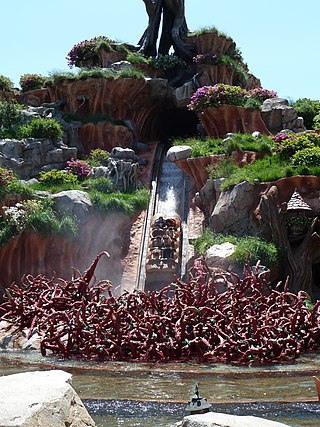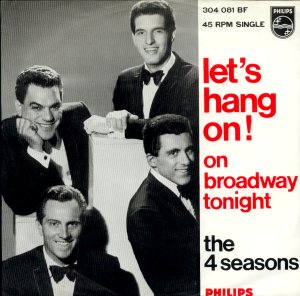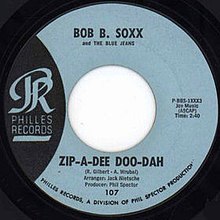
Song of the South is a 1946 American live-action/animated musical drama film directed by Harve Foster and Wilfred Jackson; produced by Walt Disney and released by RKO Radio Pictures. It is based on the Uncle Remus stories as adapted by Joel Chandler Harris, and stars James Baskett as Uncle Remus in his final film role. The film takes place in the U.S. state of Georgia during the Reconstruction era, a period of American history after the end of the American Civil War and the abolition of slavery. The story follows seven-year-old Johnny who is visiting his grandmother's plantation for an extended stay. Johnny befriends Uncle Remus, an elderly worker on the plantation, and takes joy in hearing his tales about the adventures of Br'er Rabbit, Br'er Fox, and Br'er Bear. Johnny learns from the stories how to cope with the challenges he is experiencing while living on the plantation.

Bob B. Soxx & the Blue Jeans was an early 1960s vocal group produced by Phil Spector, and was initially conceived as a vehicle for the lead vocals of Bobby Sheen, who took the stage name Bob B. Soxx. The Blue Jeans were backing vocalists Darlene Love and Fanita James, both of whom were also members of the girl group the Blossoms.

Splash Mountain is a log flume ride at Tokyo Disneyland. It was formerly located at Disneyland and Magic Kingdom. The attraction is based on the animated sequences of Disney's 1946 film Song of the South. The ride experience begins with a peaceful outdoor float-through that leads to indoor dark ride segments, with a climactic steep drop into a "briar patch" followed by an indoor finale. The drop is 52.5 feet.
"Blues in the Night" is a popular blues song which has become a pop standard and is generally considered to be part of the Great American Songbook. The music was written by Harold Arlen, the lyrics by Johnny Mercer, for a 1941 film begun with the working title Hot Nocturne, but finally released as Blues in the Night. The song is sung in the film by William Gillespie.
"Bibbidi-Bobbidi-Boo" is a novelty song, written in 1948 by Al Hoffman, Mack David, and Jerry Livingston. Introduced in the 1950 film Cinderella, and performed by actress Verna Felton, the song is about the Fairy Godmother transforming an orange pumpkin into a white carriage, four brown mice into white horses, a gray horse into a white-haired coachman and a brown dog into a white-haired footman. The song was nominated for the Academy Award for Best Original Song in 1951 but lost out to "Mona Lisa" from Captain Carey, U.S.A. Disney used the song once again in their 2015 remake of Cinderella which starred Lily James in the leading role. The song was performed by Helena Bonham Carter, who plays Fairy Godmother, and was the final song of the movie, playing with the end credits. Bonham Carter's version can also be found as the 30th song on the original movie soundtrack.
Fantasy in the Sky was the first fireworks performance at Disneyland in Anaheim, California, beginning in 1958 and running until 1996. The show also appeared at the Magic Kingdom in Lake Buena Vista, Florida from 1971 until 2003, at Tokyo Disneyland in Urayasu, Chiba, Japan from 1983 until 1988 and at Disneyland Paris from 1993 to 2005 in Marne-la-Vallee, France.

Disney Sing-Along Songs is a series of videos on VHS, betamax, laserdisc, and DVD with musical moments from various Disney films, TV shows, and attractions. Lyrics for the songs are sometimes displayed on-screen with the Mickey Mouse icon as a "bouncing ball". Early releases open with a theme song introduction containing footage featuring Professor Owl and his class, seen originally in 1953 in two Disney shorts, Melody and Toot, Whistle, Plunk, and Boom. Professor Owl hosts some of the videos, while either Jiminy Cricket or Ludwig Von Drake host others. Later volumes, as well as the two Christmas videos, do not feature a host at all. Scenes with Jiminy Cricket and Ludwig Von Drake were taken from television programs, including the Walt Disney anthology television series and The Mickey Mouse Club, which featured the characters in the 1950s and 1960s.
"Chapel of Love" is a song written by Jeff Barry, Ellie Greenwich and Phil Spector, and made famous by The Dixie Cups in 1964, spending three weeks at number one on the Billboard Hot 100. The song tells of the happiness and excitement the narrator feels on her wedding day, for she and her love are going to the "chapel of love", and "[they'll] never be lonely anymore." Many other artists have recorded the song.
"A Gal in Calico" is a song by American composer Arthur Schwartz, with words written by Leo Robin.

The Mickey Mouse Revue was an indoor audio-animatronic stage show at the Magic Kingdom and Tokyo Disneyland theme parks. It was one of the three original opening day attractions in Magic Kingdom's Fantasyland in 1971. After closing at Magic Kingdom in 1980, it was moved to Tokyo Disneyland for that park's opening in 1983 where it remained for 26 years before closing permanently in 2009.
"The Happiest Girl in the Whole USA" is a country and pop music song written, composed, and recorded by Donna Fargo. It is written in the voice of a newlywed girl, sung to her new husband. It has since become her signature song.

"Da Doo Ron Ron (When He Walked Me Home)" is a song written by Jeff Barry, Ellie Greenwich and Phil Spector. It first became a popular top five hit single for the American girl group the Crystals in 1963. American teen idol Shaun Cassidy recorded the song in 1977 and his version hit number one on the Billboard Hot 100 chart. There have also been many other cover versions of this song, including one by the songwriters Jeff Barry and Ellie Greenwich themselves, performing as the Raindrops.

The Blossoms were an American girl group that originated from California. During their height of success in the 1960s, the group's lineup consisted of Darlene Love, Fanita James, and Jean King.

"Let's Hang On!" is a song composed by Bob Crewe, Sandy Linzer, and Denny Randell that was popularized by the Four Seasons in 1965.

Robert Joseph Sheen was an American rhythm and blues singer.
Don Randi is an American keyboard player, bandleader, and songwriter who was a member of the Wrecking Crew.

"Why Do Lovers Break Each Other's Heart", sometimes shown as "Why Do Lovers Break Each Others Hearts" or "Why Do Lovers (Break Each Other's Heart)", is a pop song written by Phil Spector, Ellie Greenwich and Tony Powers. It was written as a tribute to Frankie Lymon, and was first recorded by Bob B. Soxx and the Blue Jeans. Their version featured lead vocals by Darlene Love, and reached no.38 on the Billboard Hot 100 in early 1963.

The Archies is the debut studio album by The Archies, a fictional pop band from the Archie comics. The album was originally released on the Calendar Records label in 1968 and included 12 songs. It was produced by Jeff Barry and co-produced by Don Kirshner. The band's debut single was "Bang-Shang-A-Lang"; it peaked at No. 22 on the Billboard Hot 100 in 1968. The album peaked on the Billboard 200 chart at number 88. The song "Seventeen Ain't Young" became a Top 40 hit in Australia for Frank Howson in 1969.
The Alley Cats were a musical group active in 1960s. One of their releases saw moderate airplay and chart action.

Disney Songs the Satchmo Way is a 1968 album of music from Disney films by the trumpeter and singer Louis Armstrong and produced by Tutti Camarata.












